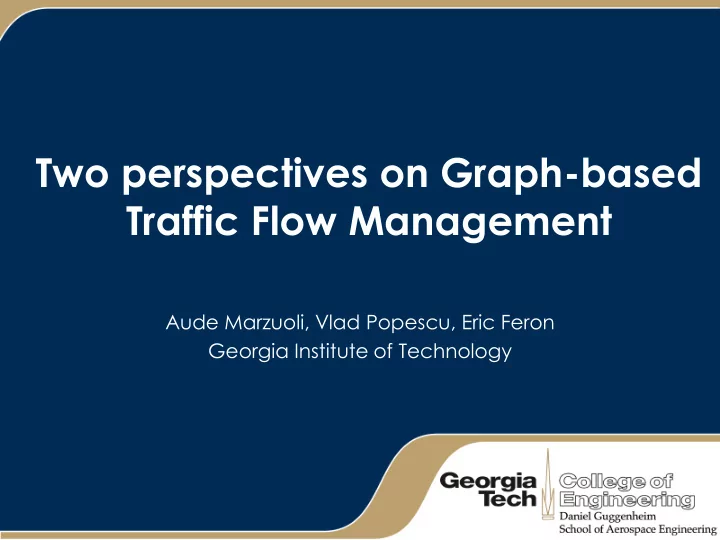

Two perspectives on Graph-based Traffic Flow Management Aude Marzuoli, Vlad Popescu, Eric Feron Georgia Institute of Technology
Slide 2 Presentation Outline • Introduction • Graph Abstraction of the Airspace • Traffic Flow Management on the Network Model • Mean Field Games Approach • Conclusion & Future Work
Slide 3 Introduction : Motivation • Expected growth of Air Transportation • Need for decision support tools for mid-term and long-term Traffic Flow Management • Current tools based on filed flight plans and prediction of aircraft arrival times
Introduction : Slide 4 Why build a TFM framework ? Density Plot for one day of Traffic (ETMS data) compared with Air and Jet routes in the Cleveland center • Traffic is more diverse and complex that what the air routes alone suggest. • Need for a precise and accurate understanding of the airspace.
Slide 5 Introduction : Two Perspectives • Goal : Optimize aircraft routing to reduce congestion and delays, while allowing more aircraft in an airspace and ensuring high safety levels • Centralized approach to simulate realistic traffic through an airspace • Decentralized approach to identify and forecast systemic congestion and delays caused by local interactions and strategies of aircraft
Graph Abstraction : Slide 6 From Trajectories to Flows Trajectory Clustering Process (Salaun et al. 2011)
Graph Abstraction : Slide 7 From Trajectories to Flows • Data set of 338,060 trajectories • 80% of traffic clustered into 690 flows
Slide 8 Graph Abstraction : From Flows to a directed Network • Locate spatial areas common to different flows, and identify the ones suitable for rerouting -> 1198 inside nodes • Define entry and exit nodes of the airspace, using k-means clustering -> 90 nodes • Create the edges that link the nodes along the flows -> 3085 edges • Extract the 218 origin-destination pairs inside the network from data -> 90% of traffic travels on 40% of the OD pairs
Slide 9 Graph Abstraction : From Flows to a directed Network
Slide 10 Centralized approach : TFM on the network & Linear Formulation • Linear Programming Approach : • All problems solved using CPLEX solver. • Flow constraints : local and global conservation of flow, flow rate limited on each edge • Linear Formulation for the Flow Constraints of about 273,000 lines.
Slide 11 TFM on the network : Linear Formulation & Controller Taskload Monitor Alert Parameter : # of • aircraft allowed in a sector at any time. Approximates average workload limit of controllers Complexity measures provide • a better indication of controller workload (e.g. Dynamic Density) Network formulation allows • consideration of complexity
Slide 12 TFM on the network : Linear Formulation & Controller Taskload Controller Taskload Approach • Arrival Acknowledgements • • Ascending/Descending/Level Departure Hand-offs • Turning aircraft flows • Potential conflicts at • Merges/crossings/intersections Taskload complexity sum the expected effort required to • manage the airspace. Sector Constraint: total allowed C C • C allowed : Maximum stead-state time effort • of controller – 50%
TFM on the network : Slide 13 Influence of sector constraints • Sector constraints limit the throughput. • With sector constraints, the main routes only are travelled. • When accounting for conflicts, spreading on the edges. • Results obtained : bounds, no realistic demand pattern.
Slide 14 TFM on the network : Throughput & Demand patterns • Constriction of the throughput by demand patterns, that may or may not be accommodated • Identification of nominal networks by data-mining • Comparison with airspace state under weather perturbations • Evaluation of re-routing costs • Definition of “best routes”
Decentralized Approach : Slide 15 Mean Field Games • Mean field games refine Eulerian flow models • Agent preferences & strategies • Agent expectations (information) • Mixed population • Suitable to model numerous agents with marginal influence • Continuous density approximation
Decentralized Approach : Slide 16 Mean Field Games Feedback coupling • Agent strategies vs population dynamics • Strategy (HJB) backward in time • Dynamics (FP) forward in time • • Microscopic rational agents anticipate macroscopic system dynamics • Agents develop strategies depending on their preferences and cost • Preferences : destination, routings • Cost: fuel, aversion to congestion /delays
Slide 17 Application of MFG to the network • Explicit formulations in the paper • Quadratic cost function – Congestion aversion – Deviations from preferred routings – Discount factor • Discretization scheme is essential • Semi-implicit discretization scheme • Numerical complexity • Forward-backward coupling • Parabolic equations
Application of MFG to the Slide 18 network : Simulation • A basic case • Very simple flow graph • 2 ways to go from source to destination • Look for static distribution of aircraft • Trust-region dogleg algorithm • Static solution • Higher density along graph edges • Lower density away – but not 0! • Demonstrates the method
Slide 19 Conclusion & Future Work • Data-based methodology for modeling an airspace as a flow network • Centralized & Decentralized approaches with same goals : simulate realistic traffic, predict congestion, mitigate its effects, both under nominal and perturbed conditions • Next steps : – Refine the models – Incorporate perturbations – Compare the performances of both models
Slide 20 Acknowledgments This work is made possible by : » NASA Ames Research Center grant NNX08AY52A (Influence of Degraded Environment on Airspace Safety) » Air Force Office of Scientific Research grant FA9550-08-1-0375 (Coordinated Multi- Disciplinary Design of Complex Human Machine Systems)
Recommend
More recommend